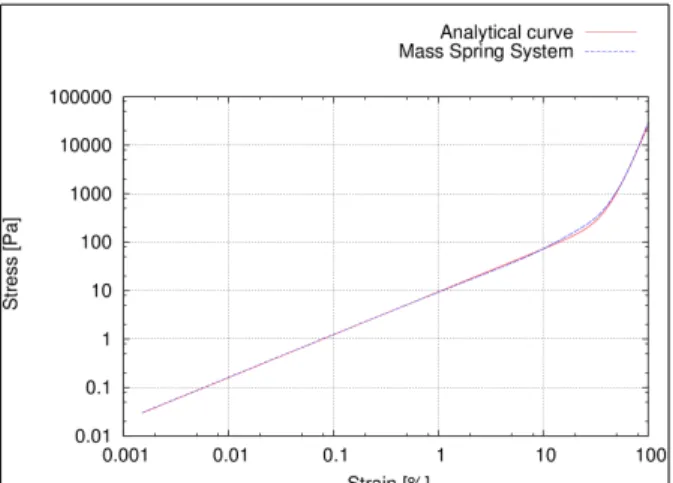HAL Id: hal-01320714
https://hal.archives-ouvertes.fr/hal-01320714
Submitted on 26 May 2016HAL is a multi-disciplinary open access
archive for the deposit and dissemination of sci-entific research documents, whether they are pub-lished or not. The documents may come from teaching and research institutions in France or abroad, or from public or private research centers.
L’archive ouverte pluridisciplinaire HAL, est destinée au dépôt et à la diffusion de documents scientifiques de niveau recherche, publiés ou non, émanant des établissements d’enseignement et de recherche français ou étrangers, des laboratoires publics ou privés.
New Mass Spring System formulation to model the
behavior of soft tissues
Karolina Golec, Florence Zara, Stéphane Nicolle, Jean-François Palierne,
Guillaume Damiand
To cite this version:
Karolina Golec, Florence Zara, Stéphane Nicolle, Jean-François Palierne, Guillaume Damiand. New Mass Spring System formulation to model the behavior of soft tissues. 22nd European Society of Biomechanics Congress (ESB 2016), Jul 2016, Lyon, France. �hal-01320714�
New Mass Spring System formulation to model the behavior of soft tissues
Karolina Golec (1), Florence Zara (1), Stéphane Nicolle (2), Jean-François Palierne (3), Guillaume Damiand (1)
1. Univ Lyon, Université Lyon 1, CNRS, LIRIS, UMR5205, F-69622, Lyon, France; 2. Univ Lyon, Université Lyon 1, IFSTTAR, LBMC, F-69675 Lyon, France;
3. École Normale Supérieure de Lyon, Laboratoire de Physique, CNRS, UMR5672, Lyon, France
Introduction
Computer-based medicine has been largely developed in recent years for helping surgery, diagnosis and treatment [1]. Unfortunately, from a mechanical standpoint, modeling complex materials such as soft tissues is still a challenge requiring accuracy and possibility of user interaction.
Among computational models (such as Finite Element Method [2], or Position Based Dynamics [3]), we chose the Mass-Spring System (MSS) as model. It offers several advantages, like adaptability and fast computation, while allowing topological modifications (like cutting or piercing) without pre-computations. In this paper we present a new MSS formulation for soft tissue simulations. The validation of the mechanical response of the model is based on work of Nicolle et al. [4] which reported the shear behavior of three vital internal organs (kidney, liver and spleen). Our method is based on a topological-physical model called TopoSim [5,7] which allows to easily implement different physical models and performs fast and accurate modeling of different kinds of tissues. Thanks to this model, we are able to easily adapt the simulation to desired requirements and to perform topological modifications during simulations if necessary.
Method
The environment damping and the tissue’s parameters (like Young's modulus, Poisson's ratio, density) are directly connected to the parameters of the MSS. With the formulation proposed in [6] we compute the stiffness (k) of springs. Then, we propose to change the usual springs' force formulation to be able to reproduce the analytical solution reported by Nicolle [4]. Our non-linear formulation of the force of springs (equation 1) allows us to reconstruct the viscous part (the term in first brackets) artificially. We derive it from both: viscous and elastic terms. In the formula c represents the spring damping, n, p are constants and l0
and l are respectively initial and the current spring length.
F=
(
c
⋅
dl
dt
+
k
⋅
(
l −l
0)
1 − n)
(
1+α
|
l −l
0|
p −(1 −n))
α=
1
n⋅l
0 p−1 (1)Results
We compare our results obtained for shearing solicitations with the analytical model proposed by Nicolle. We studied the force response of the top layer
of the tissue, exactly as performed for the real tissue experiments. We executed the simulation on liver tissue at 0.0151 s-1 strain rate and present results obtained in Fig. 1.
Figure 1: MSS simulation and the analytical curve: comparison (log-log scale)
Discussion
In our simulation experiments we successfully reproduce the non-linear viscoelastic behavior of soft tissues. However, we are working on a generic formulation, which will enforce the correct response in an easy and natural way for different deformation speeds, under other mechanical solicitations. We are working on simulations for other tissues (kidney, liver).
References
1. Duan et al, Conference Proceedings IEEE Eng Med
Biol Soc, 2013: 4941-4944, 2013
2. Jerabkova et al, IEEE Computer Graphics and
Applications, 29: 61-71, 2009
3. Müller et al, Journal of Visual Communication and Image Representation, 18:109-118, 2007.
4. Nicolle et al, Journal of the Mechanical Behavior
of Biomedical Materials, 9: 130-136, 2012.
5. Golec et al, 23rd International Conference on
Computer Graphics WSCG: 25-34, 2015.
6. Baudet et al, 17th International Conference on
Computer Graphics WSCG: 145-152, 2009.
7. Flechon et al, 21st International Conference on
Computer Graphics WSCG: 104-113, 2013.
Acknowledgements
This work was supported by the LABEX PRIMES (ANR-11-LABX-0063) of Université de Lyon, within the program "Investissements d’Avenir" (ANR-11- IDEX-0007) operated by the French National Research Agency (ANR).
